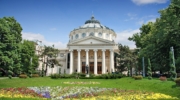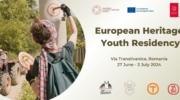Cultural heritage projects featured during European Week of Regions and Cities
This year’s European Week of Regions and Cities – a four-day event bringing together stakeholders and decision-makers in Brussels – was held on 9-11 October and featured many successful cultural heritage projects that had benefited from EU funding. In fact, one of the key themes was education, culture and youth and numerous events focus on cultural heritage and its various contributions to social and economic cohesion. The 2018 edition not only coincided with the European Year of Cultural Heritage, it was also a celebration of 30 years of EU Cohesion Policy. It was also a premiere for Europa Nostra whose small delegation participated in various events. Secretary General Sneška Quaedvlieg-Mihailović moderated the seminar Cultural Heritage: Worth the Investment? The European Week was co-organised by the European Committee of the Regions (CoR) and the European Commission’s Directorate-General for Regional Policy.
One of the key political moments of the European Week was the address “State of the European Union: the View of Regions and Cities” of CoR President Karl-Heinz Lambertz – who had also been one of the speakers at the European Cultural Heritage Summit 2018 and one of the first to sign the Berlin Call to Action: “Cultural Heritage for the Future of Europe”. Europa Nostra’s Secretary General Sneška Quaedvlieg-Mihailović and Vice-President Piet Jaspaert congratulated President Lambertz on his speech which highlighted the role of regions and cities in strengthening the European Union.
Last night in Brussels: celebrating the #RegioStars2018 winners with our dear colleagues & supporters from @EU_CoR: its President Lambertz & its Rapporteur on Cultural Heritage Babette Winter @CoR_President @europanostra #EuropeForCulture #EURegionsWeek #CohesionAlliance pic.twitter.com/3f1P7uafUS
— Sneška Quaedvlieg-Mihailović (@SneskaEN) October 10, 2018
The highlight of the European Week was the RegioStars Awards Ceremony that took place on the same day. The RegioStars award celebrates excellent and best practice in EU-funded projects and is awarded in four categories plus a category of the year. On the occasion of the European Year, the additional 2018 topic of the year was “Investing in cultural heritage”. Here, the project Nant Gwrtheyrn about an abandoned mining village on the north west Wales coast, which has been restored to become a cultural centre, was the winner. The public choice award went to the Vista Alegre Heritage Museum in Portugal.
Great initiative for #RegioStars2018 Topic of the Year: “Investing in Cultural Heritage”! Congrats to inspiring finalists & to the winner @NantGwrtheyrn1 from Wales/UK 👏👏👏 @CorinaCretuEU @EUinmyRegion @CoR_President @mmarkkula #EURegionsWeek #CohesionAlliance #EuropeForCulture pic.twitter.com/JhNZM01BYC
— Europa Nostra (@europanostra) October 9, 2018
The RegioStars award winners and many other successful projects supported by EU cohesion funds demonstrate the added value of this policy. In fact, 10% of the overall budget of the EU Interreg programme (up until 2017), for instance, went to cultural projects, as representatives of the European Commission’s Directorate-General for Regional Policy outlined at another event dedicated to cultural cooperation. Project representatives present also shared some of the lessons learned, such as how crossing borders empowers you, how industrial heritage can be used for tourism and how important public-private partnerships are. On this occasion, the European Commission presented the e-book “Connecting Cultures, Connected Citizens,” which features a selection of inspiring examples of territorial and cross-border cooperation related to cultural heritage.
Great to see inspiring examples of heritage-led urban regeneration at #EURegionsWeek! 😀
Many projects were funded under EU Interreg programme. Read about their success stories here ➡️https://t.co/ril44d2fPI@RegioInterreg#EuropeForCulture#Heritage4Europe#CohesionAlliance pic.twitter.com/2Ax44RbF27— Europa Nostra (@europanostra) October 10, 2018
Europa Nostra’s Council member Pavlos Chatzigrigoriou also participated in the European Week and shared his experience with the EU Interreg programme, which, in his view, is not yet sufficiently known among heritage stakeholders albeit it provides many opportunities for heritage-related projects.
The European Commission also co-organised a session on how to ensure quality in EU-funded heritage and architectural projects, which also linked to the Davos Declaration on high-quality Baukultur adopted earlier this year.
Besides the official programme, many stakeholders organised side events during the European Week, such as European Cultural Tourism Network (ECTN) – a member organisation of Europa Nostra – and NECSTouR. Both networks are also members of the European Heritage Alliance 3.3.







